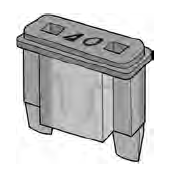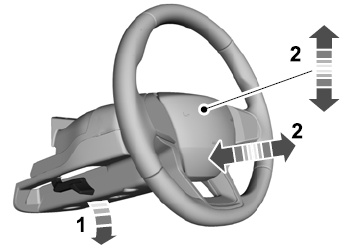Lincoln Aviator 2020-2025 Owners Manual / Customer Assistance / Changing a Fuse
Lincoln Aviator: Customer Assistance / Changing a Fuse
Fuses
WARNING: Always replace a fuse with one that has the specified amperage rating. Using a fuse with a higher amperage rating can cause severe wire damage and could start a fire.

If electrical components in the vehicle are not working, a fuse may have blown. Blown fuses are identified by a broken wire within the fuse. Check the appropriate fuses before replacing any electrical components.
Fuse Types



 Passenger Compartment Fuse Panel
Passenger Compartment Fuse Panel
The fuse panel is under the instrument panel
to the left of the steering column.
Note: It may be easier to access the fuse
panel if you remove the finish trim piece...
 Maintenance
Maintenance
..
Other information:
Lincoln Aviator 2020-2025 Service Manual: Description and Operation - Cruise Control - System Operation and Component Description
System Operation Non-Adaptive Cruise Control Item Description 1 Brake switch assembly 2 IPC 3 Accelerator pedal 4 Deactivator switch 5 Stoplamp switch 6 SCCM 7 PCM 8 Cruise control switches 9 GWM 10 ABS module 11 RCM 12 Steering Effort Control Module (SECM) (adaptive steering) 13 SASM (adaptive steering) 14 SIMA Network Message Chart Network Input Messages - IPC Broadcast Message Originating Module Message Purpose Cruise control override PCM Driver overriding cruise control with accelerator pedal...
Lincoln Aviator 2020-2025 Service Manual: Diagnosis and Testing - Parking Aid
Diagnostic Trouble Code (DTC) Chart Diagnostics in this manual assume a certain skill level and knowledge of Ford-specific diagnostic practices. REFER to: Diagnostic Methods (100-00 General Information, Description and Operation). Diagnostic Trouble Code Chart Module DTC Description Action APIM C1001:01 Vision System Camera:General Electrical Failure GO to Pinpoint Test A APIM C1001:01 Vision System Camera:General Electrical Failure GO to Pinpoint Test J APIM C1001:02 Vision System Camera:General Signal Failure GO to Pinpoint Test A APIM C1001:1C Vision System Camera:Circuit Voltage Out Of Range GO to Pinpoint Test A APIM C1001:4B Vision System Camera:Over Temperature GO to Pinpoint Test H APIM C1001:55 Vision System Camera:Not Configured GO to Pinpoint Test I APIM C1001:81 Vision System Camera:Invalid Serial Data Received GO to Pinpoint Test A APIM C1001:87 Vision System Camera:Missing Message GO to Pinpoint Test A IPMB B115E:31 Camera Module:No Signal GO to Pinpoint Test L IPMB B115E:49 Camera Module:Internal Electronic Failure GO to Pinpoint Test T IPMB B12BE:31 Left Front Camera:No Signal GO to Pinpoint Test N IPMB B12BE:49 Left Front Camera:Internal Electronic Failure GO to Pinpoint Test U IPMB B12BF:31 Right Front Camera:No Signal GO to Pinpoint Test O IPMB B12BF:49 Right Front Camera:Internal Electronic Failure GO to Pinpoint Test V IPMB B148E:31 Front Camera:No Signal GO to Pinpoint Test M IPMB B148E:49 Front Camera:Internal Electronic Failure GO to Pinpoint Test W IPMB B14A5:11 Multi-Camera View Switch:Circuit Short To Ground GO to Pinpoint Test P IPMB C1001:78 Vision System Camera:Alignment Or Adjustment Incorrect GO to Pinpoint Test X IPMB U0100:00 Lost Communication With ECM/PCM "A":No Sub Type Information GO to Pinpoint Test Y IPMB U0121:00 Lost Communication With Anti-Lock Brake System (ABS) Control Module:No Sub Type Information GO to Pinpoint Test Z IPMB U0121:87 Lost Communication With Anti-Lock Brake System (ABS) Control Module "A":Missing Message GO to Pinpoint Test Z IPMB U0131:00 Lost Communication With Power Steering Control Module:No Sub-Type Information GO to Pinpoint Test AA IPMB U0131:87 Lost Communication With Power Steering Control Module "A":Missing Message GO to Pinpoint Test AA IPMB U0138:00 Lost Communication with All Terrain Control Module:No Sub Type Information GO to Pinpoint Test AB IPMB U0140:00 Lost Communication With Body Control Module:No Sub Type Information GO to Pinpoint Test AC IPMB U0146:00 Lost Communication With Gateway "A":No Sub Type Information GO to Pinpoint Test AD IPMB U0212:00 Lost Communication With Steering Column Control Module:No Sub Type Information GO to Pinpoint Test AJ IPMB U0253:87 Lost Communication With Accessory Protocol Interface Module:Missing Message GO to Pinpoint Test AK IPMB U0293:00 Lost Communication with Hybrid/EV Powertrain Control Module:No Sub Type Information GO to Pinpoint Test Y IPMB U0300:57 Internal Control Module Software Incompatibility:Invalid/Incompatible Software Component GO to Pinpoint Test AN IPMB U0401:00 Invalid Data Received from ECM/PCM A:No Sub Type Information GO to Pinpoint Test Y IPMB U0415:00 Invalid Data Received from Anti-Lock Brake System (ABS) Control Module "A":No Sub Type Information GO to Pinpoint Test Z IPMB U0420:00 Invalid Data Received from Power Steering Control Module "A":No Sub Type Information GO to Pinpoint Test AA IPMB U0422:00 Invalid Data Received From Body Control Module:No Sub Type Information GO to Pinpoint Test AC IPMB U0423:82 Invalid Data Received from Instrument Panel Cluster Control Module:Alive/Sequence Counter Incorrect/Not Updated GO to Pinpoint Test AE IPMB U0424:00 Invalid Data Received From HVAC Control Module:No Sub Type Information GO to Pinpoint Test AF IPMB U0424:82 Invalid Data Received From HVAC Control Module:Alive/Sequence Counter Incorrect/Not Updated GO to Pinpoint Test AF IPMB U0428:00 Invalid Data Received From Steering Angle Sensor Module:No Sub Type Information GO to Pinpoint Test AG IPMB U0485:82 Invalid Data Received From Radio:Alive/Sequence Counter Incorrect/Not Updated GO to Pinpoint Test AH IPMB U0553:82 Invalid Data Received From Lighting Control Module-Rear "B":Alive/Sequence Counter Incorrect/Not Updated GO to Pinpoint Test AI IPMB U0554:00 Invalid Data Received From Accessory Protocol Interface Module:No Sub Type Information GO to Pinpoint Test AK IPMB U0554:82 Invalid Data Received From Accessory Protocol Interface Module:Alive/Sequence Counter Incorrect/Not Updated GO to Pinpoint Test AK IPMB U0594:00 Invalid Data Received From Hybrid/EV Powertrain Control Module:No Sub Type Information GO to Pinpoint Test Y IPMB U1000:11 Solid State Driver Protection Active -Driver Disabled:Circuit Short To Ground GO to Pinpoint Test AL IPMB U2024:41 Control Module Cal-Config Data:General Checksum Failure GO to Pinpoint Test AM IPMB U2100:00 Initial Configuration Not Complete:No Sub Type Information GO to Pinpoint Test AM IPMB U2101:00 Control Module Configuration Incompatible:No Sub Type Information GO to Pinpoint Test AM IPMB U3000:42 Control Module:General Memory Failure GO to Pinpoint Test AN IPMB U3000:49 Control Module:Internal Electronic Failure GO to Pinpoint Test AN Symptom Chart(s) Rear Only Parking Aid Camera Diagnostics in this manual assume a certain skill level and knowledge of Ford-specific diagnostic practices...
Categories
- Manuals Home
- Lincoln Aviator Owners Manual
- Lincoln Aviator Service Manual
- USB Port and Power Point Locations
- Disabling Auto-Start-Stop
- Remove and Reinstall the Battery
- New on site
- Most important about car
Adjusting the Steering Wheel - Vehicles With: Manual Adjustable Steering Column
WARNING: Do not adjust the steering wheel when your vehicle is moving.
Note: Make sure that you are sitting in the correct position.
Unlock the steering column. Adjust the steering wheel to the desired position.
Copyright © 2025 www.liaviator2.com
